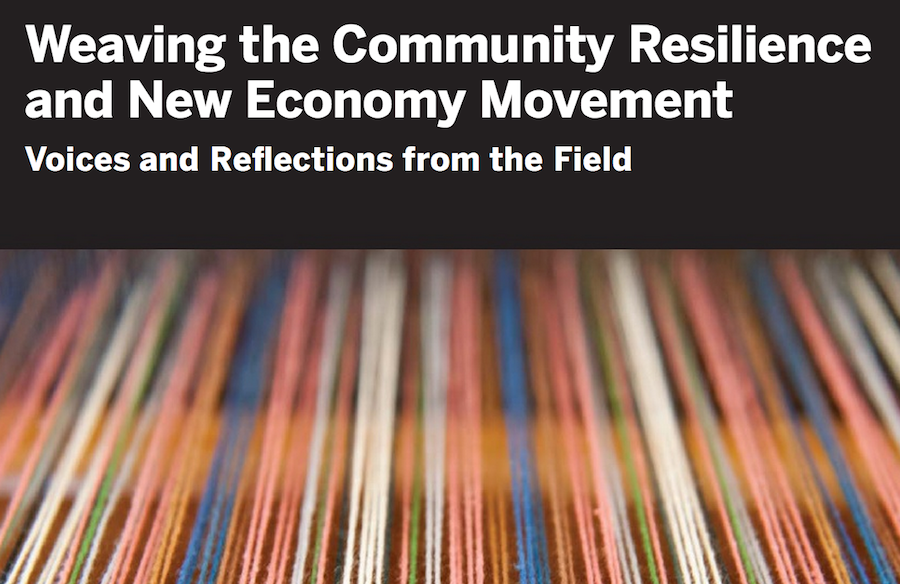The new economy has several different names including the sharing economy, the solidarity economy, community resilience, transition, the oppositional economy, and more. At its core, however, is an awareness that the existing economy, which thrives on maximizing growth and profits at all expense, has failed us.
Although various organizations and movements work on different facets of social change and have different beliefs and methods, there’s a lot of common ground including a desire for a healthy environment, thriving communities, equitable distribution of wealth, sustainable lifestyles, and strong democracies. There’s a largely unacknowledged shared vision among groups, but there’s not yet an overarching movement that unifies them all into a cohesive group. The Community Resilience and New Economy Movement (CRNE) aims to change that, at least in North America.
For the report “Weaving the Community Resilience and New Economy Movement: Voices and Reflections from the Field,” presented by the Post Carbon Institute, CRNE researchers interviewed dozens of leaders within the new economy, environmental, social justice, labor, democracy and indigenous rights movements to find the places that they interconnect. Interviewees included Noel Ortega from the Institute for Policy Studies, New Economy Working Group; Michael Toye from the Canadian Community Economic Development Network; Joe Grafton from American Independent Business Alliance; Sarah Baird from the Center for a New American Dream; Carolyne Stayton from Transition US; John Duda from the Democracy Collaborative; Sandy Wiggins from the Business Alliance for Local Living Economies; and Shareable’s Mira Luna.
What they found was “a portrait of a rich and vibrant movement, full of promise and hope for a better future and still very much in formation with many opportunities for creative engagement, collaborative movement-building, visioning, and developing strategy.” Spotlighting this shared vision is just a beginning and there's much work to be done. It's an interesting and important attempt to bring cohesion to these diverse movements. Here are a few key points from the report:
- The CRNE movement goes beyond the oversimplified, often-argued capitalism vs. socialism. This is much more creative, responsive, democratic, diverse and dynamic.
- This movement requires a cultural shift in values away from a focus on material wealth, and toward building vibrant, healthy communities and ecosystems.
- Finding creative ways to fund these various organizations is key to the movement’s success as many organizations doing important work struggle to make ends meet.
- There are tensions within this new movement including what to prioritize, how to most effectively address inequality, and the best strategies to get from where we currently are to where we want to be.
Looking ahead, researchers asked participants to look back from a future five years from now in which the CRNE movement has been wildly successful. Here are a few responses:
“Today, as for the last several years, the US Census Bureau has finished its third random survey of the happiness of all of America, because this is the indicator used by federal policymakers to guide our future. States and localities are following suit.”
—Laura Musikanski, The Happiness Alliance“Across place, these new forms of economy are rooted in diverse forms of leadership. For example, immigrant communities of the South of the US have literally been at the heel of the boot of the dominant economy, but are now located at the center of these new forms of democratic governance. There is a truly multi-racial expression, a cross-class expression of leadership and creation and vision and application being manifested everywhere that gives life to what deep democracy means from the workplace up to the statehouse.”
—Mateo Nube, Movement Generation“There are now hundreds of ‘Local Economy’ or ‘Livability Centers’ across the United States. They're in small rural towns, suburbs and neighborhoods in big cities—Chicago has five of them! They are physical centers and the go-to place for education, action and starting new local businesses. The Centers are the focal point for the sustainability movement in each location. And they ROCK! They are totally supported by a diverse array of income streams.”
—Kelley Rajala, Livability Project“There's economic power at the local level and more cooperation than competition. It's a mature ecosystem, symbiotic, and different organizations have their niches. In 2019 we see businesses are more locally owned. Most assets are held collectively since we've identified that that is the most advantageous way to live. There's a lot more inter-connectedness and connectedness in our locales. Community wealth is measured not by GDP but in the health of relationships of mutual support and cooperation, on the well-being of community.”
—Carolyne Stayton, Transition US“The community owns its own energy, owns common land together, has common telecommunications services. The commons has grown—it had been shrinking —and this network of [sharing] cities has really blossomed and is taking ownership of its own destiny. The models that are emerging are being spread through the network, virally and organically, replicating in a way that reflects each community's culture and goals. And when I say sharing I mean anything from public banking and alternative currencies, housing and food cooperatives, Makerspaces and art collectives.”
—Mira Luna, Shareable
See the other respondents’ vision for the future and read the full report: Weaving the Community Resilience and New Economy Movement
##
Follow @CatJohnson on Twitter









